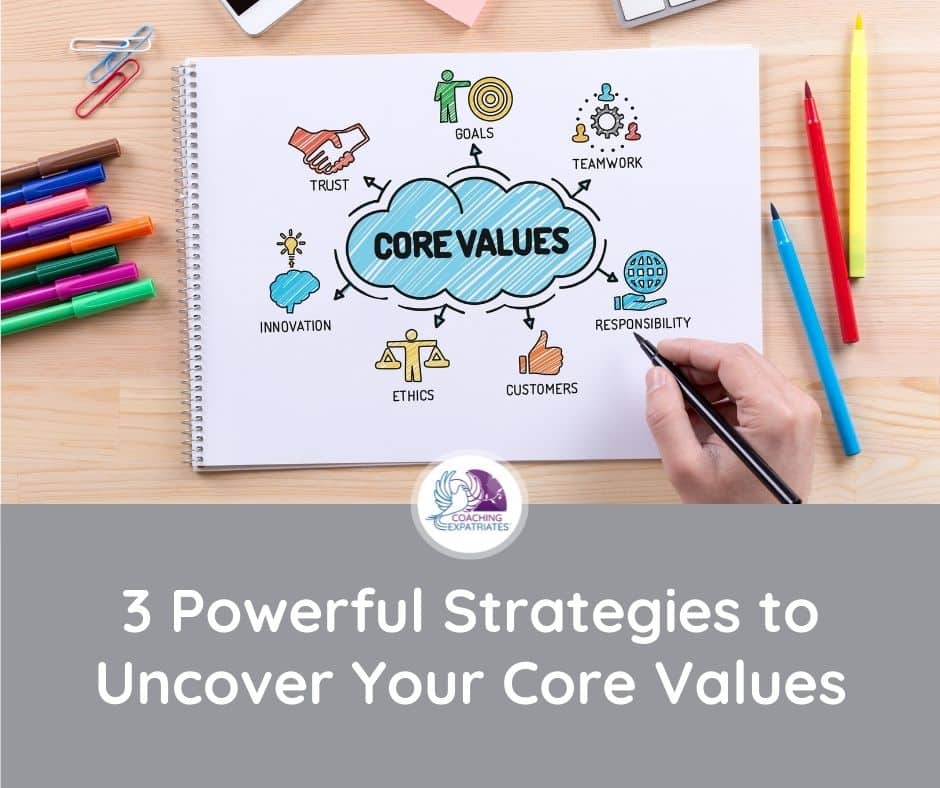Have you ever wondered why the biggest companies in the world have clear definitions for vision, mission, and values? One of the reasons why core values are so important to companies is because these help them drive decisions, narratives, and behavior, not only for the company as an entity but also for its employees. It sets goals and expectations for what is appropriate within that organization.
Successful people also identify and develop a clear and meaningful set of values and priorities for themselves because these values help them drive decisions and behaviors in their lives. Taking the hesitation factor out of the way makes people quicker and more assertive in their ways.
But what exactly is “Value” in this context? If you check the dictionary, you might find something along the lines of Value being a person’s principles or standards of behavior; one’s judgment of what is essential in life. So, in a nutshell, Values are guiding principles and perspectives you acquired in life, in many ways: through your parents, teachers, experiences, peers, culture, society, religion, care-takers, successes, failures, and so on. I like to call them “Core Values” because Values are usually aligned with your core, fundamental being.
What is also critical to mention is that setting values is not the same as having values. Although indeed, you acquire many types of values and perspectives in life, since you are in command here, you can choose the values that serve you best and your purpose in life. So it is part of your job to roll up your sleeves and work on defining, sorting out, and prioritizing what your core values are. This makes the whole difference between setting them and just having them. Just having values means you loosely know what your value system is and what’s important to you, but you cannot truly pinpoint your driving factors. Setting Values speaks to the fact that not only do you know what your Values are, but you carefully defined and chosen them.
In this post, we will share 3 strategies to help you with that. Defining and choosing your own set of Core Values might not be totally easy, but it is well worth the time and effort. Doing this will yield blessings through your actions.
Setting your Core Values and Priorities
Values change over time because circumstances change, we learn with new experiences, and we always have newer external influences. A year ago, before the Covid19 pandemic, our set of values might have been very different from those that we have today. Because things change, values change. Here are a few suggestions on how to best define them. For all strategies below, you will need a list of core values to choose from. You can either use Coaching Expatriates Core Values List, or any other one you might find on the internet. Just make sure your list has around 50 different values or more to choose from so that you are allowed a higher amplitude of options and possibilities to consider.
1. Drilling down process
Take the List of Core Values and select an initial set of 50 values, if your list has more than that. Divide them into 5 buckets of 10, according to the following definition:
Bucket 1 – I always value this.
Bucket 2 – I frequently value this.
Bucket 3 – I value this more often than not.
Bucket 4 – I rarely value this.
Bucket 5 – I don’t value this as much, or it is circumstantial when I value this
You are allowed only 10 Values in each bucket. It is ok to change your mind and jiggle around the Values from one bucket to the other until you get a clearer picture of where they really belong. Don’t put too much pressure on yourself. And if you do, ask yourself if there is any value attached to this behavior.
Right now, you will have 10 values in each of the buckets. The next step is to take 4 values out from each of the buckets. Do you have now to reorder each bucket? Did anything change on how frequently you value things based on this exclusion factor? Once you completed this step, you will have 6 Values in each bucket. Your bucket 1 is your main Core Values Set – the driving forces of your behavior, actions, and decisions. The other buckets are also important, as they are adjuvants in reminding you what other things are also vital to you, and that you also frequently value or consider when making decisions.
2. Highlighting process
Identify 5 significant events in your life and 5 critical people that have a form of impact in your life or behavior. It could be either good or bad events and people. Write down 1 to 3 things each event and person taught you in life, and that is important to you right now. For example, let’s say you chose your father. Your father (either because he taught you himself or because he led you to learn that through good or bad ways) showed you the importance of “Integrity.”
If you had terrible events, try to think about what they taught you. The opposite of the feeling that bad event or person generated might also give you clues to what your values are. For example, let’s say you experienced a Tsunami, and you saw despair, hopelessness, death. Maybe the event taught you the importance of preparedness, or the importance of compassion, or perhaps collaboration amongst survivors. These could be driving values to you now, that were created because of this experience.
Once you defined all values that events and people have taught you, it’s time to select your top 6. All of them are important, of course, but think about what values are non-negotiable to you and that you always value, no matter what the circumstances. Once you select your top 5 or 6, this will be your Core Values Set – the driving forces of your behavior, actions, and decisions. The other ones are also important, as they are adjuvants to remind you what other things are important to you and how they came about (through the experiences and people you selected), and that you also frequently Value or consider.
3. Points Attribution process
To identify the most significant values to you, you can use this process if you are more prone to mathematical and rational approaches. Go over each item in your Core Values List and assign a number from 1 to 5 to each one of the values according to its importance, 1 being not important, 2 being somewhat important, 3 being quite important, 4 being very important, and 5 being of utmost importance. Select all the elements you attributed the number 5, and you will have a brand new list, with fewer items.
With this new list, go one by one, and assign a number from 1 to 5, now answering how often do you display this Value in your life, 1 being rarely, 2 being sometimes, 3 being often times, 4 being quite frequently, and 5 being always. This will create a column of numbers, that for our purposes, we will call it “Column A.” Now create a new column to the right, which we will call it “Column B”, with a new set of numbers from 1 to 5, now answering how often would you like to display that Value in your life, 1 being rarely, 2 being sometimes, 3 being often times, 4 being frequently, and 5 being always.
Now that you have a list with columns A and B, as one last step, multiply the amounts in column A times Colum B. Put these multiplied amounts in a new column to the right – let’s call it “Column C.” Go over your column C and select 6 Values that had the highest scores. If you have more than 6 Values with the same or similar scores, try to sort out which of the highest 6 makes more sense to you as your main drivers.
Frequency of Core Values Setting
Values change over time, as said. Therefore, it is critical to review your set of Core Values from time to time. You will be surprised how they either could change or change in terms of priority. What was once in Bucket 1 might now be in Bucket 2. Once you defined your initial set of values, write them down, along with the date these values were identified, and create a tentative expiration date, so that you can remind yourself to redo the exercise at that time. For example, let’s say you created your set of Core Values today, write today’s date, and let’s say you want to review them and redo this exercise in one year. The expiration date would be one year from now. Or six months from now. Whatever the time length you choose.
Working on this exercise at least yearly is my recommendation because it shows what has changed over the past year that has influenced the way you see things. The greater the awareness you have about yourself and your surroundings, the higher effectiveness you will have when engaging with them. If this exercise is overwhelming for you to do alone, hire a certified executive or life coach, or do it with someone with experience in this field. Some individuals who are external or verbal processors prefer to work on this exercise with another person, and that is perfectly natural. By having your core values clearly defined, you’ll create blessings (for yourself and others) through your driven and purposeful actions.
Group Core Values Setting
I once did this exercise with a group that was working already very well together. What was surprising was that 3 values amongst the 6 each individual selected were present in everyone else’s selection. This meant the group shared 3 values. That made my job a lot easier. Then we defined another 3 values that would be set for the group. It was, as usual, a heated and fruitful discussion that ended up clarifying vision and purpose for that group. That helped them work even better together.
I strongly recommend that something similar is also done with your group at work. Whether you work for a big corporation or any other type of organization, having a shared set of Core Values and vision helps a lot in driving decisions and behavior. See a step by step suggestion on how you can do this:
Step 1 – Set aside at least 2.5 hours for a team-building event. Be mindful that bigger teams might need longer times.
Step 2 – Ask each individual in the group to define their top 5 or 6 values.
Step 3 – Ask each individual to share their top 5 or 6 values and what each means to them and why they are important.
Step 4 – Ask the group to discuss values in general for that particular group and what should drive the prioritization process. It could be from one of the 3 strategies above, or they can define that it will come from those Values already selected by them as individuals. Let them drive the conversation. It’s their team, after all.
Step 5 – Ask the group to define the top 15 values for the group based on their decision in Step 4.
Step 6 – Next, ask the group to choose if they will try to use an exclusion method (like strategy 1) or an inclusion method (like strategy 2) for defining the final top 5/6. Using strategy 3 can be done, but you want them to discuss and create awareness of what is important as a group, and the last strategy is not so conducive to that, as it’s geared more toward internal processors that need rational methodologies. It is, however, effective to use strategy 3 as an initial Values drill down, for big teams – teams that have more than 8 or 10 people in the team-building.
Step 7 – Ask the group to choose the final top 5/6 values that will define their group’s values, based on their decision in Step 6.
Hopefully, this will be a fun and exciting exercise for the team, that will help them get better clarity on what is crucial for them as a team, and what are the value drivers that should help guide their actions and behaviors as a group. It is essential to remind them that having a set of group values does not diminish the importance of their own personal set of values.
As a facilitator, be watchful for individuals who have hugely discrepant values from the group. That person might need support, counseling, or repurposing within the group or the company if their values are not in some degree of alignment with the group and the company.
Final remarks
Hopefully, this post has given you a new glimpse of the importance of value setting and how it could be done. Now it is time for you to take action. Either as an individual or as a leader, start setting and reviewing values for yourself and your group.
If you enjoyed this post, share it with your co-workers, your company, your HR, other leaders, and get their perspective on the subject. The more awareness you gain of yourself, your surroundings, and its people, the higher effectiveness you’ll have when engaging with them. So start exploring and gaining understanding. Your actions will yield immense awareness and personal power.
Also, consider subscribing to our newsletter. We mail only once per week and we never share your information. We focus on content for global leaders in productivity, habits and mindset, and leadership skills. If that sounds great, use the form below to subscribe.







